FORD F650 2003 10.G Owners Manual
Manufacturer: FORD, Model Year: 2003, Model line: F650, Model: FORD F650 2003 10.GPages: 248, PDF Size: 2.54 MB
Page 121 of 248
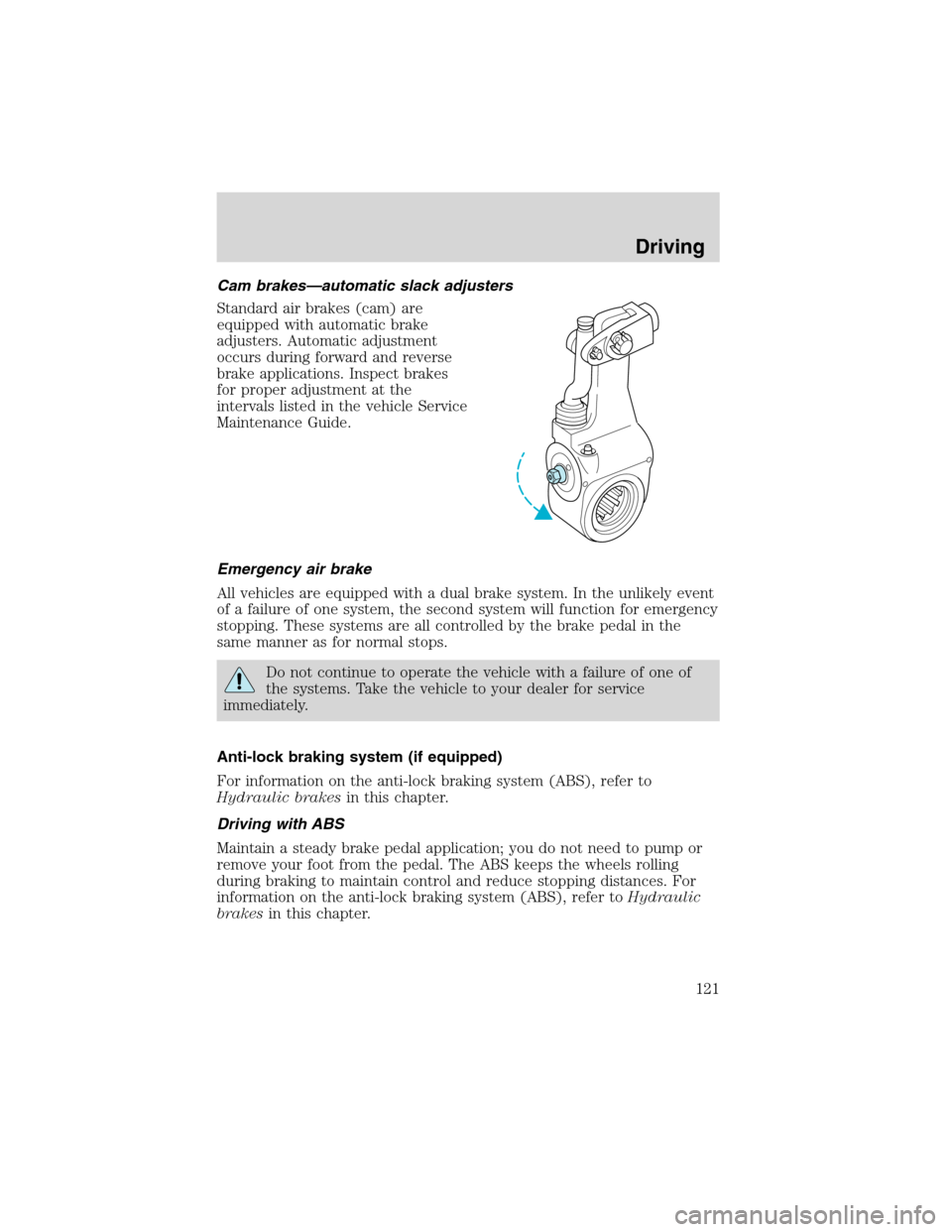
Cam brakes—automatic slack adjusters
Standard air brakes (cam) are
equipped with automatic brake
adjusters. Automatic adjustment
occurs during forward and reverse
brake applications. Inspect brakes
for proper adjustment at the
intervals listed in the vehicle Service
Maintenance Guide.
Emergency air brake
All vehicles are equipped with a dual brake system. In the unlikely event
of a failure of one system, the second system will function for emergency
stopping. These systems are all controlled by the brake pedal in the
same manner as for normal stops.
Do not continue to operate the vehicle with a failure of one of
the systems. Take the vehicle to your dealer for service
immediately.
Anti-lock braking system (if equipped)
For information on the anti-lock braking system (ABS), refer to
Hydraulic brakesin this chapter.
Driving with ABS
Maintain a steady brake pedal application; you do not need to pump or
remove your foot from the pedal. The ABS keeps the wheels rolling
during braking to maintain control and reduce stopping distances. For
information on the anti-lock braking system (ABS), refer toHydraulic
brakesin this chapter.
Driving
121
Page 122 of 248
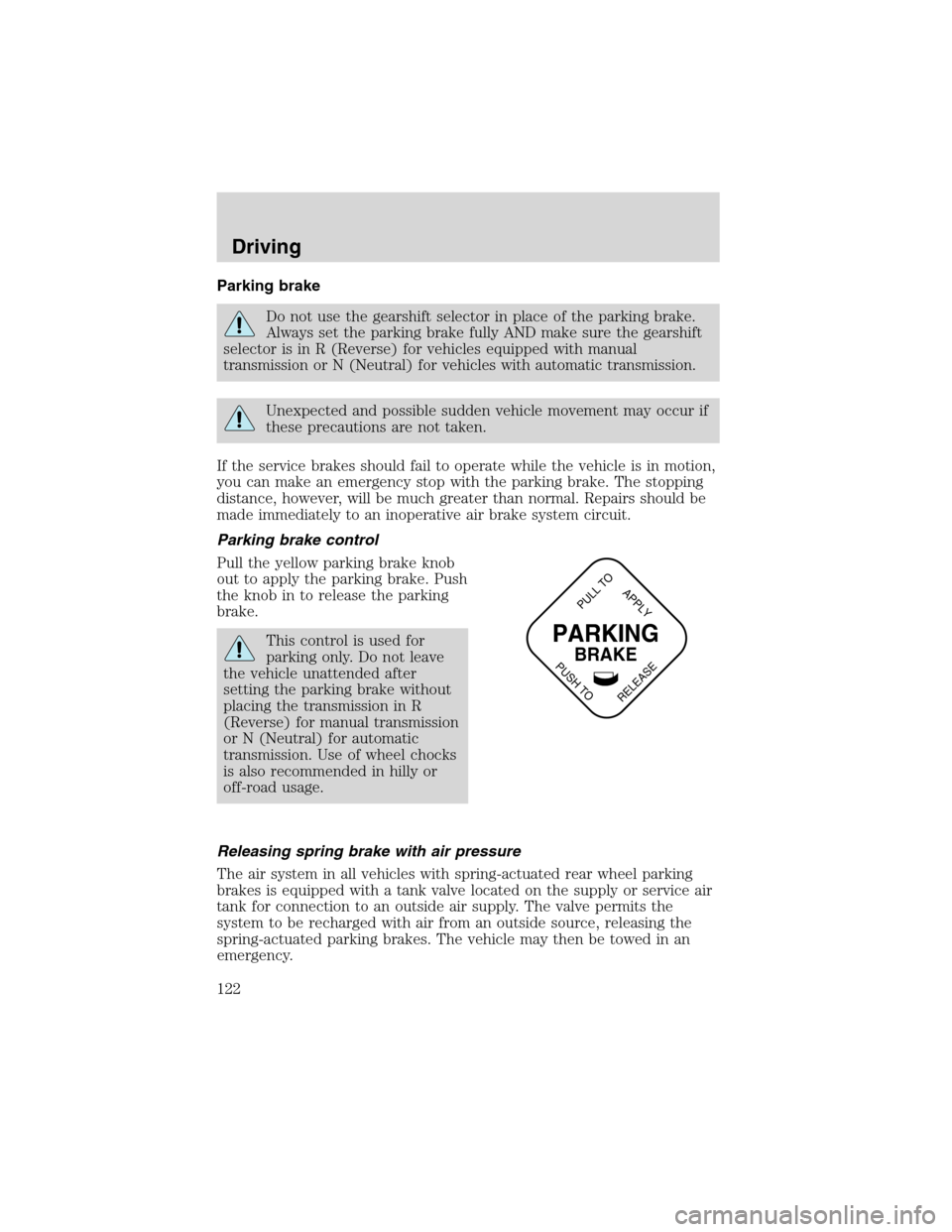
Parking brake
Do not use the gearshift selector in place of the parking brake.
Always set the parking brake fully AND make sure the gearshift
selector is in R (Reverse) for vehicles equipped with manual
transmission or N (Neutral) for vehicles with automatic transmission.
Unexpected and possible sudden vehicle movement may occur if
these precautions are not taken.
If the service brakes should fail to operate while the vehicle is in motion,
you can make an emergency stop with the parking brake. The stopping
distance, however, will be much greater than normal. Repairs should be
made immediately to an inoperative air brake system circuit.
Parking brake control
Pull the yellow parking brake knob
out to apply the parking brake. Push
the knob in to release the parking
brake.
This control is used for
parking only. Do not leave
the vehicle unattended after
setting the parking brake without
placing the transmission in R
(Reverse) for manual transmission
or N (Neutral) for automatic
transmission. Use of wheel chocks
is also recommended in hilly or
off-road usage.
Releasing spring brake with air pressure
The air system in all vehicles with spring-actuated rear wheel parking
brakes is equipped with a tank valve located on the supply or service air
tank for connection to an outside air supply. The valve permits the
system to be recharged with air from an outside source, releasing the
spring-actuated parking brakes. The vehicle may then be towed in an
emergency.PARKING
BRAKE
PULL TO
RELEASE
APPLY
PUSH TO
Driving
122
Page 123 of 248
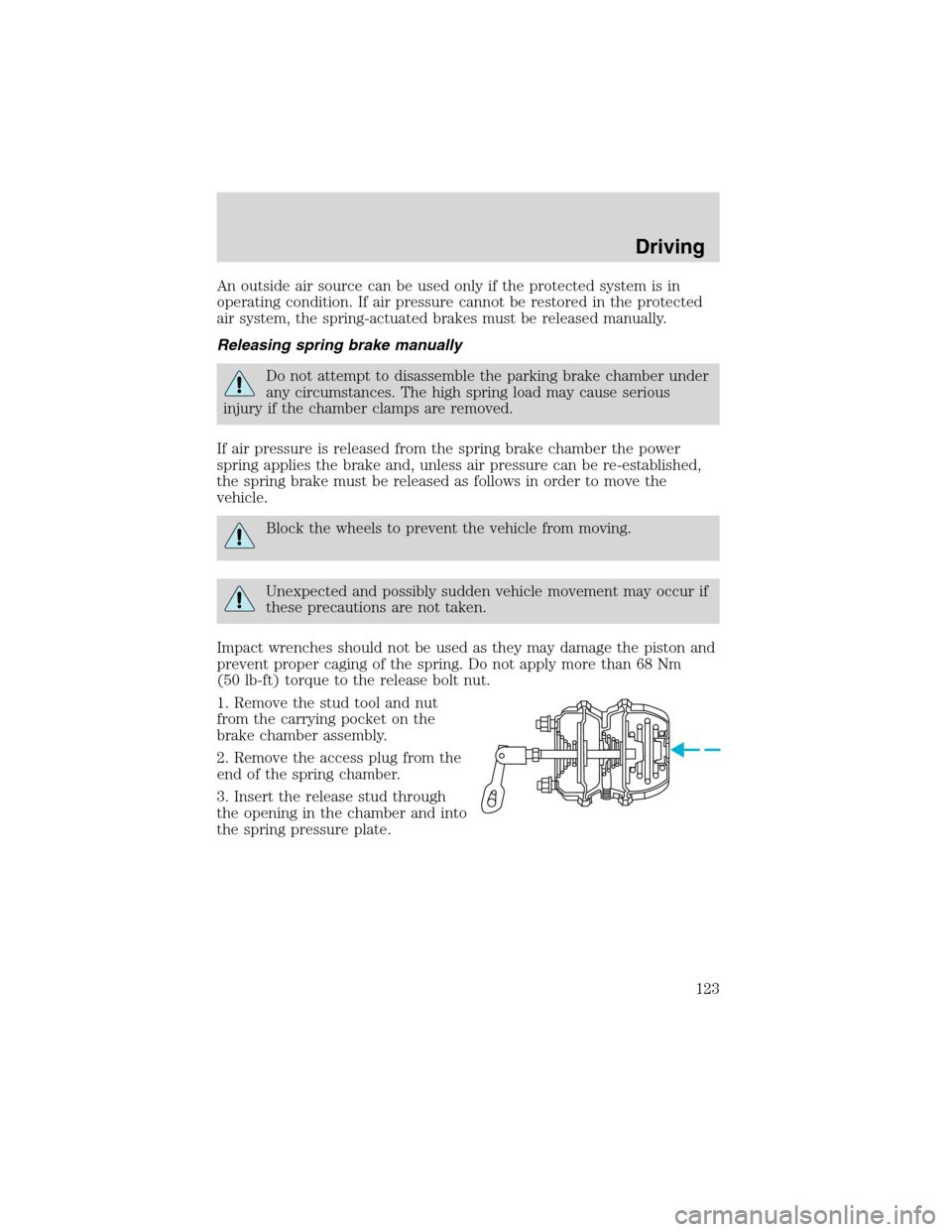
An outside air source can be used only if the protected system is in
operating condition. If air pressure cannot be restored in the protected
air system, the spring-actuated brakes must be released manually.
Releasing spring brake manually
Do not attempt to disassemble the parking brake chamber under
any circumstances. The high spring load may cause serious
injury if the chamber clamps are removed.
If air pressure is released from the spring brake chamber the power
spring applies the brake and, unless air pressure can be re-established,
the spring brake must be released as follows in order to move the
vehicle.
Block the wheels to prevent the vehicle from moving.
Unexpected and possibly sudden vehicle movement may occur if
these precautions are not taken.
Impact wrenches should not be used as they may damage the piston and
prevent proper caging of the spring. Do not apply more than 68 Nm
(50 lb-ft) torque to the release bolt nut.
1. Remove the stud tool and nut
from the carrying pocket on the
brake chamber assembly.
2. Remove the access plug from the
end of the spring chamber.
3. Insert the release stud through
the opening in the chamber and into
the spring pressure plate.
Driving
123
Page 124 of 248
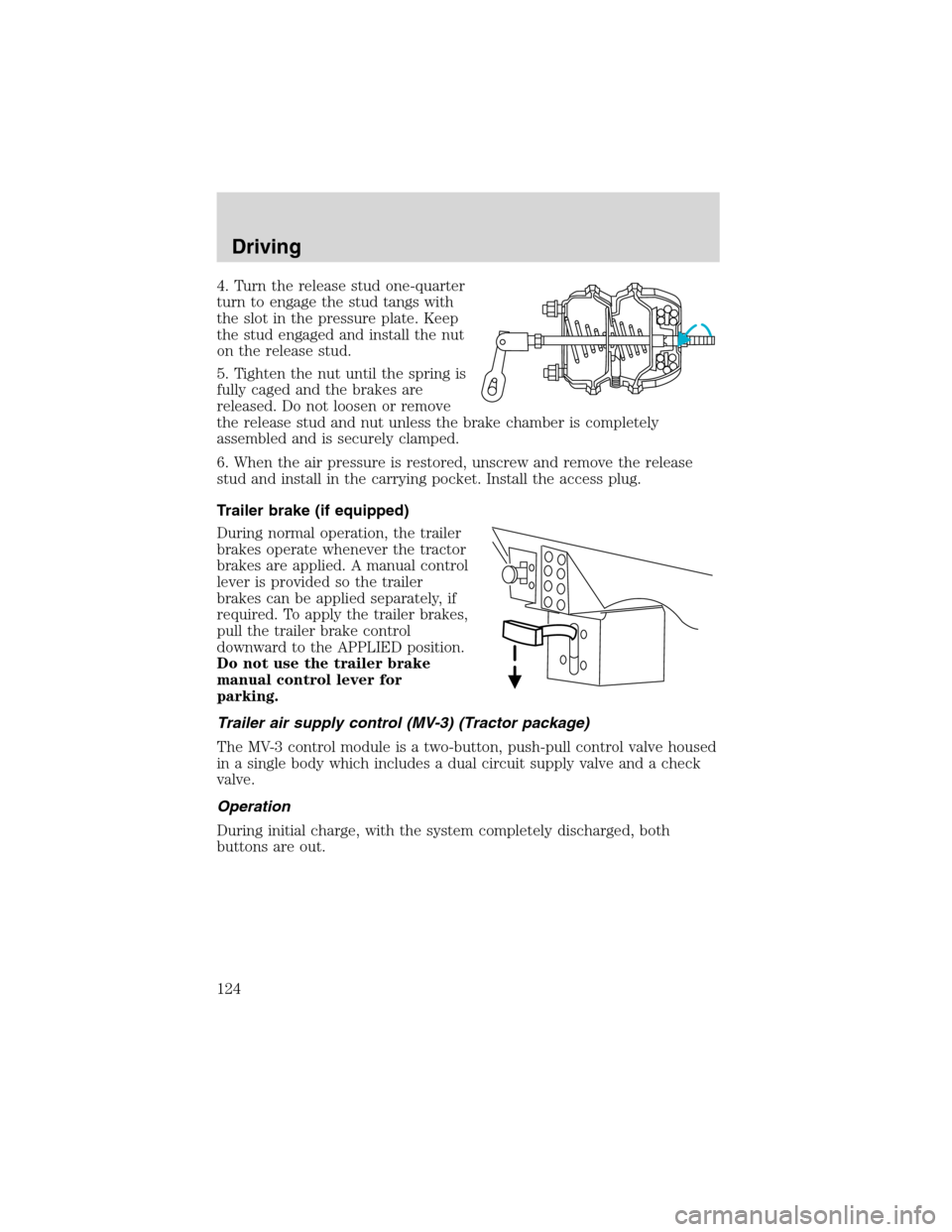
4. Turn the release stud one-quarter
turn to engage the stud tangs with
the slot in the pressure plate. Keep
the stud engaged and install the nut
on the release stud.
5. Tighten the nut until the spring is
fully caged and the brakes are
released. Do not loosen or remove
the release stud and nut unless the brake chamber is completely
assembled and is securely clamped.
6. When the air pressure is restored, unscrew and remove the release
stud and install in the carrying pocket. Install the access plug.
Trailer brake (if equipped)
During normal operation, the trailer
brakes operate whenever the tractor
brakes are applied. A manual control
lever is provided so the trailer
brakes can be applied separately, if
required. To apply the trailer brakes,
pull the trailer brake control
downward to the APPLIED position.
Do not use the trailer brake
manual control lever for
parking.
Trailer air supply control (MV-3) (Tractor package)
The MV-3 control module is a two-button, push-pull control valve housed
in a single body which includes a dual circuit supply valve and a check
valve.
Operation
During initial charge, with the system completely discharged, both
buttons are out.
Driving
124
Page 125 of 248
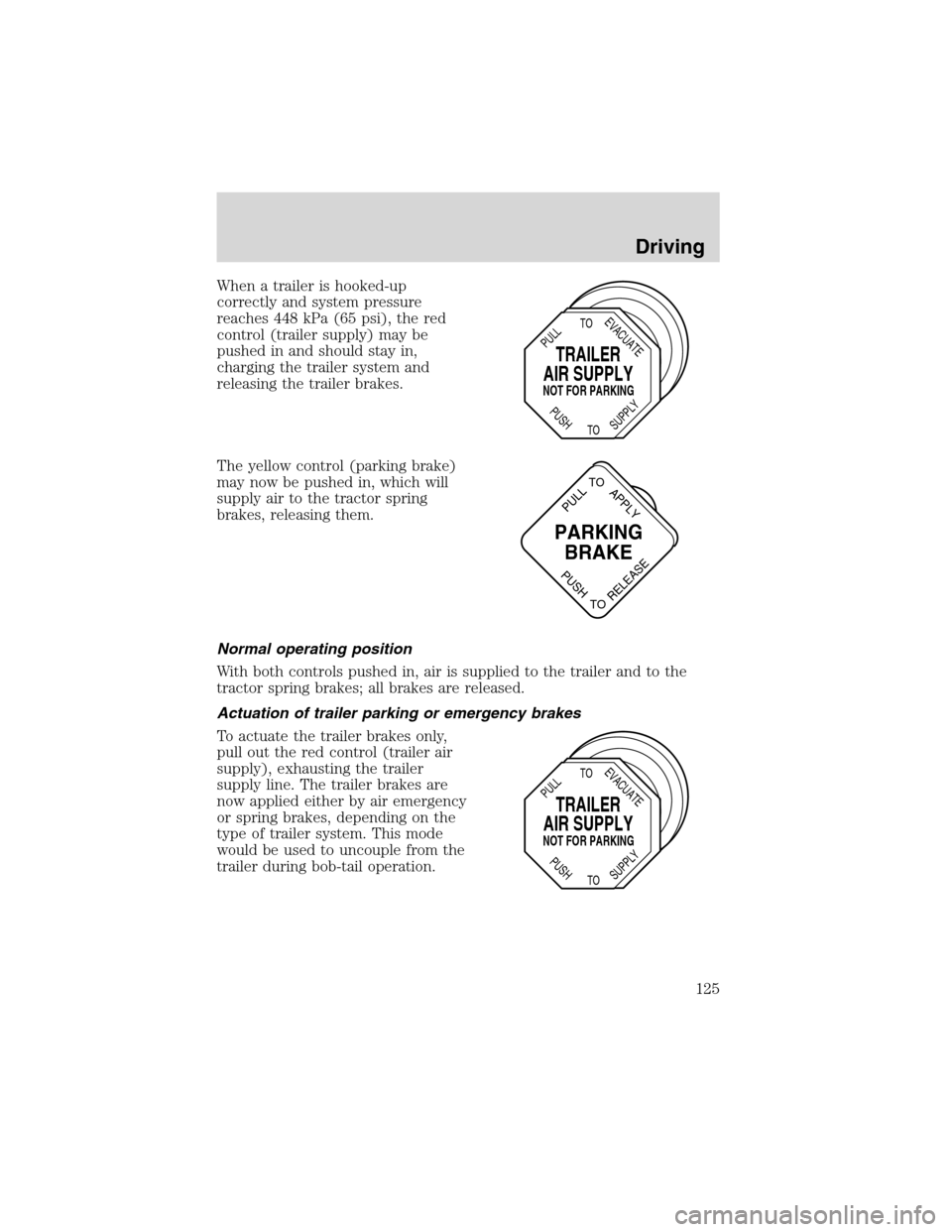
When a trailer is hooked-up
correctly and system pressure
reaches 448 kPa (65 psi), the red
control (trailer supply) may be
pushed in and should stay in,
charging the trailer system and
releasing the trailer brakes.
The yellow control (parking brake)
may now be pushed in, which will
supply air to the tractor spring
brakes, releasing them.
Normal operating position
With both controls pushed in, air is supplied to the trailer and to the
tractor spring brakes; all brakes are released.
Actuation of trailer parking or emergency brakes
To actuate the trailer brakes only,
pull out the red control (trailer air
supply), exhausting the trailer
supply line. The trailer brakes are
now applied either by air emergency
or spring brakes, depending on the
type of trailer system. This mode
would be used to uncouple from the
trailer during bob-tail operation.
TRAILER
AIR SUPPLY
NOT FOR PARKING
PULL
TO
TOEVACUATE
PUSH
SUPPLY
PARKING
BRAKE
PULL
TOAPPLY
PUSH
TORELEASE
TRAILER
AIR SUPPLY
NOT FOR PARKING
PULL
TO
TOEVACUATE
PUSH
SUPPLY
Driving
125
Page 126 of 248
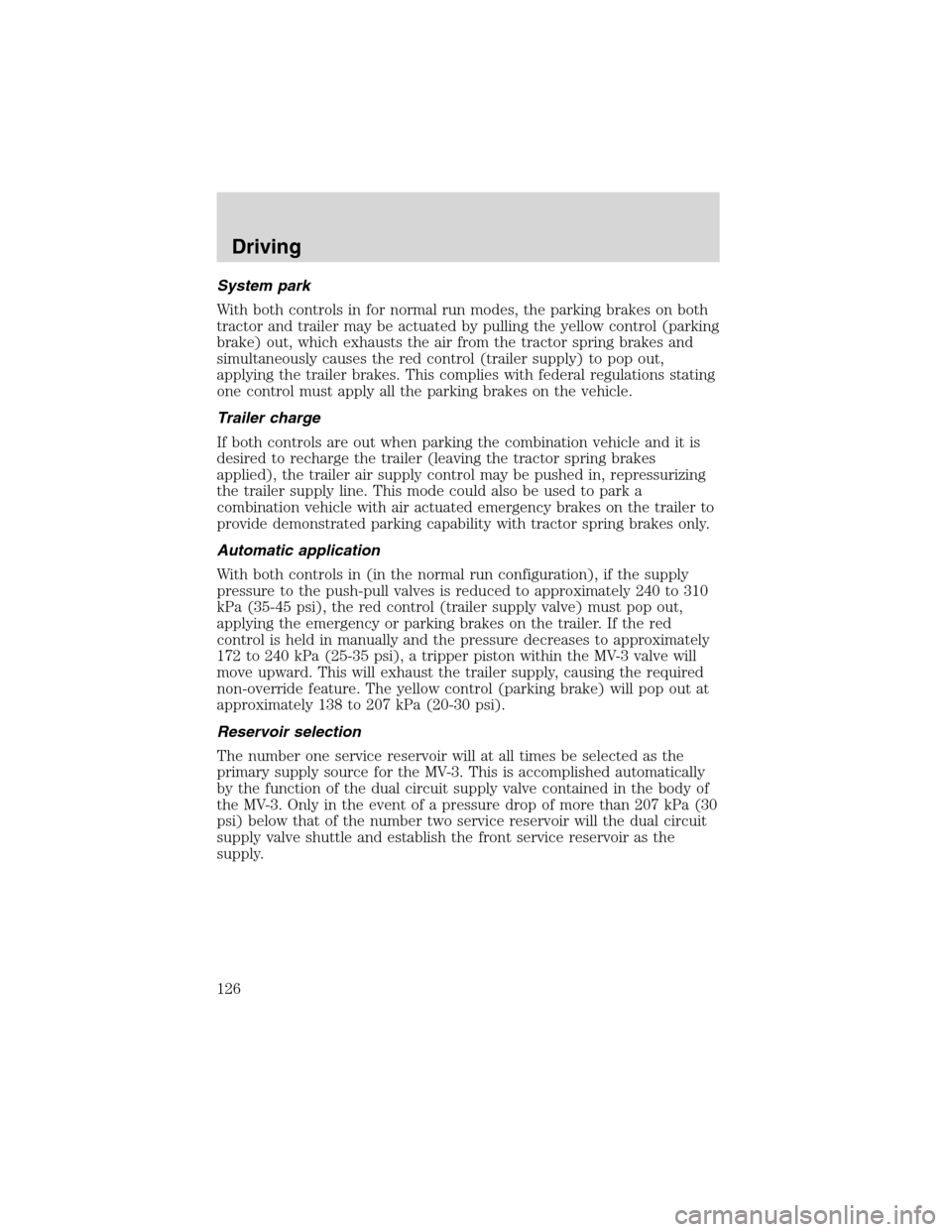
System park
With both controls in for normal run modes, the parking brakes on both
tractor and trailer may be actuated by pulling the yellow control (parking
brake) out, which exhausts the air from the tractor spring brakes and
simultaneously causes the red control (trailer supply) to pop out,
applying the trailer brakes. This complies with federal regulations stating
one control must apply all the parking brakes on the vehicle.
Trailer charge
If both controls are out when parking the combination vehicle and it is
desired to recharge the trailer (leaving the tractor spring brakes
applied), the trailer air supply control may be pushed in, repressurizing
the trailer supply line. This mode could also be used to park a
combination vehicle with air actuated emergency brakes on the trailer to
provide demonstrated parking capability with tractor spring brakes only.
Automatic application
With both controls in (in the normal run configuration), if the supply
pressure to the push-pull valves is reduced to approximately 240 to 310
kPa (35-45 psi), the red control (trailer supply valve) must pop out,
applying the emergency or parking brakes on the trailer. If the red
control is held in manually and the pressure decreases to approximately
172 to 240 kPa (25-35 psi), a tripper piston within the MV-3 valve will
move upward. This will exhaust the trailer supply, causing the required
non-override feature. The yellow control (parking brake) will pop out at
approximately 138 to 207 kPa (20-30 psi).
Reservoir selection
The number one service reservoir will at all times be selected as the
primary supply source for the MV-3. This is accomplished automatically
by the function of the dual circuit supply valve contained in the body of
the MV-3. Only in the event of a pressure drop of more than 207 kPa (30
psi) below that of the number two service reservoir will the dual circuit
supply valve shuttle and establish the front service reservoir as the
supply.
Driving
126
Page 127 of 248
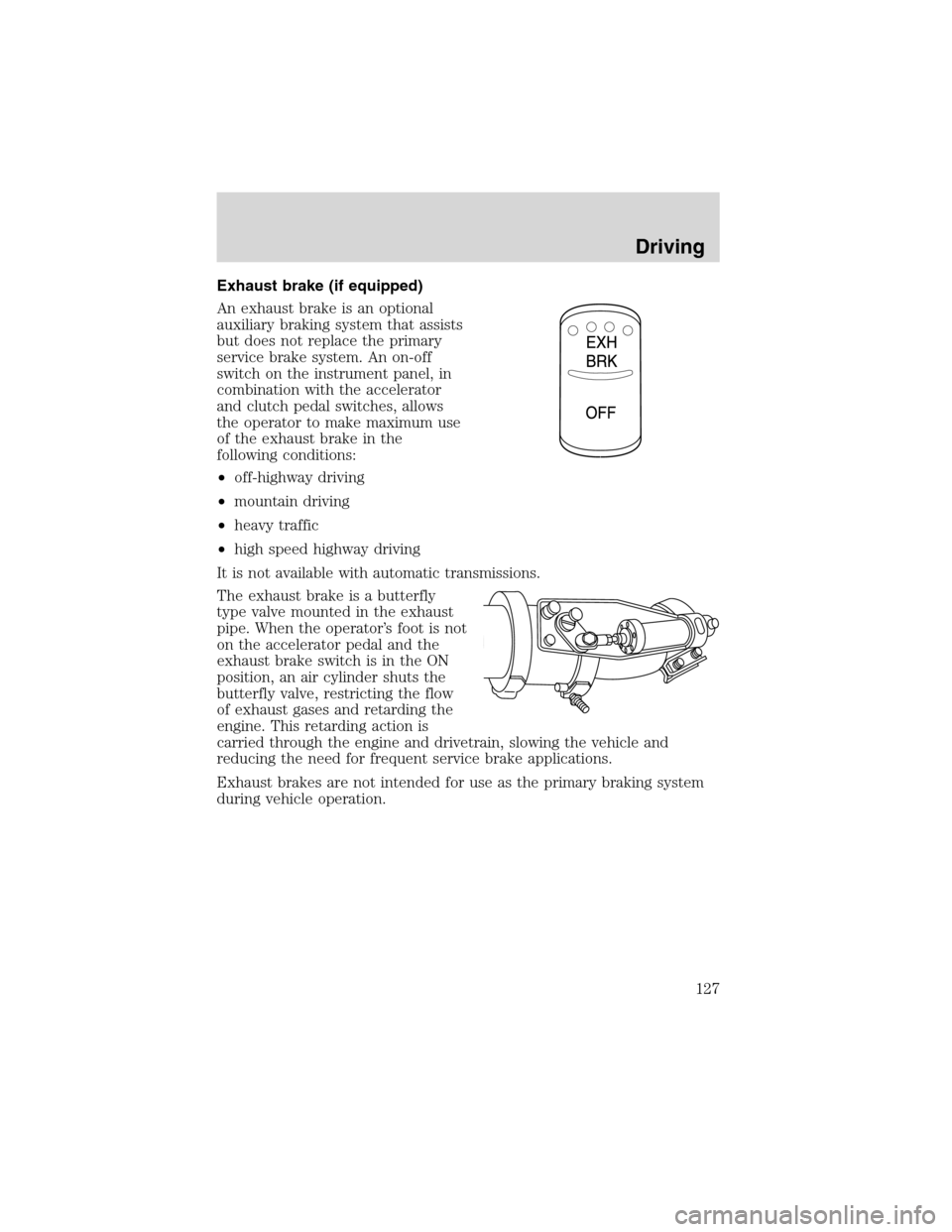
Exhaust brake (if equipped)
An exhaust brake is an optional
auxiliary braking system that assists
but does not replace the primary
service brake system. An on-off
switch on the instrument panel, in
combination with the accelerator
and clutch pedal switches, allows
the operator to make maximum use
of the exhaust brake in the
following conditions:
•off-highway driving
•mountain driving
•heavy traffic
•high speed highway driving
It is not available with automatic transmissions.
The exhaust brake is a butterfly
type valve mounted in the exhaust
pipe. When the operator’s foot is not
on the accelerator pedal and the
exhaust brake switch is in the ON
position, an air cylinder shuts the
butterfly valve, restricting the flow
of exhaust gases and retarding the
engine. This retarding action is
carried through the engine and drivetrain, slowing the vehicle and
reducing the need for frequent service brake applications.
Exhaust brakes are not intended for use as the primary braking system
during vehicle operation.
Driving
127
Page 128 of 248
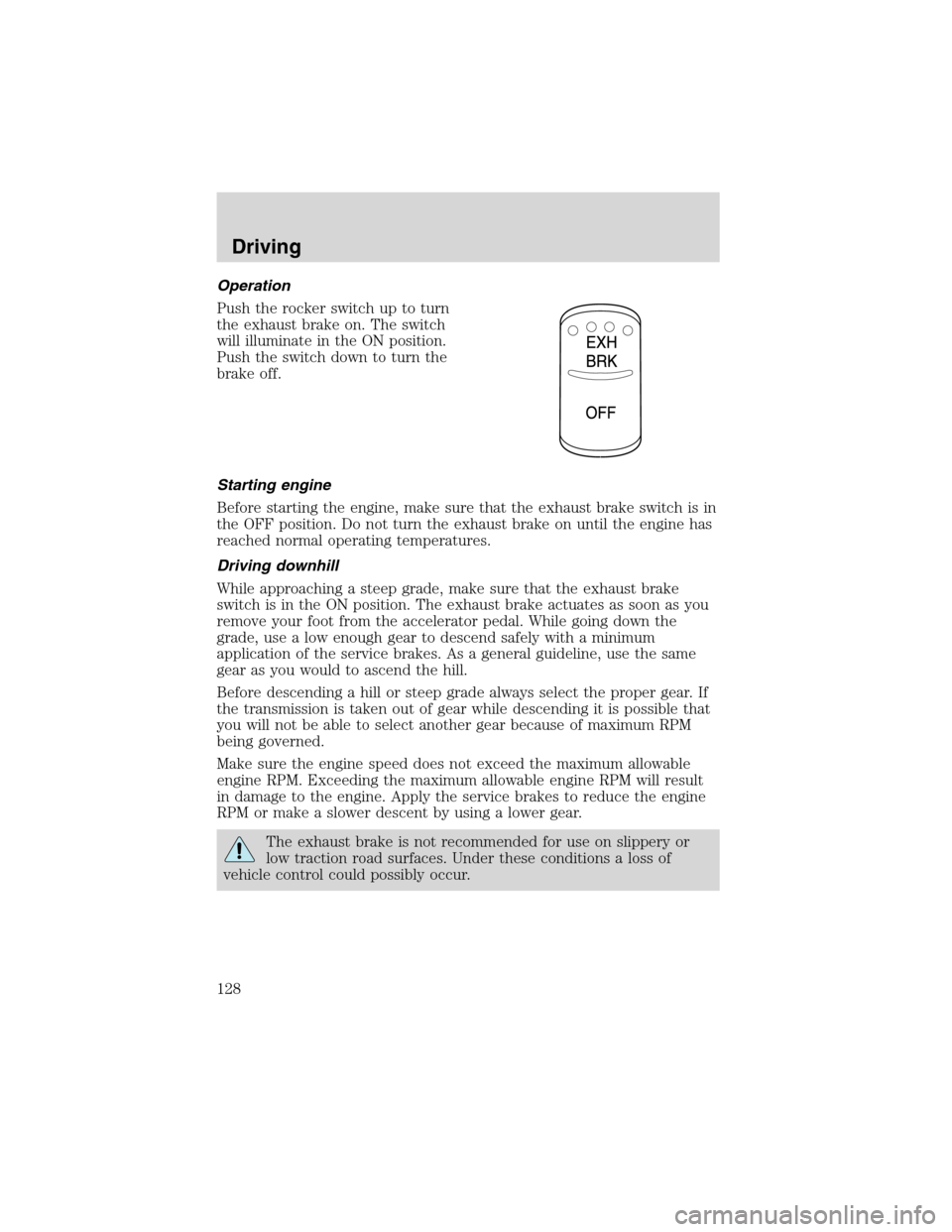
Operation
Push the rocker switch up to turn
the exhaust brake on. The switch
will illuminate in the ON position.
Push the switch down to turn the
brake off.
Starting engine
Before starting the engine, make sure that the exhaust brake switch is in
the OFF position. Do not turn the exhaust brake on until the engine has
reached normal operating temperatures.
Driving downhill
While approaching a steep grade, make sure that the exhaust brake
switch is in the ON position. The exhaust brake actuates as soon as you
remove your foot from the accelerator pedal. While going down the
grade, use a low enough gear to descend safely with a minimum
application of the service brakes. As a general guideline, use the same
gear as you would to ascend the hill.
Before descending a hill or steep grade always select the proper gear. If
the transmission is taken out of gear while descending it is possible that
you will not be able to select another gear because of maximum RPM
being governed.
Make sure the engine speed does not exceed the maximum allowable
engine RPM. Exceeding the maximum allowable engine RPM will result
in damage to the engine. Apply the service brakes to reduce the engine
RPM or make a slower descent by using a lower gear.
The exhaust brake is not recommended for use on slippery or
low traction road surfaces. Under these conditions a loss of
vehicle control could possibly occur.
Driving
128
Page 129 of 248
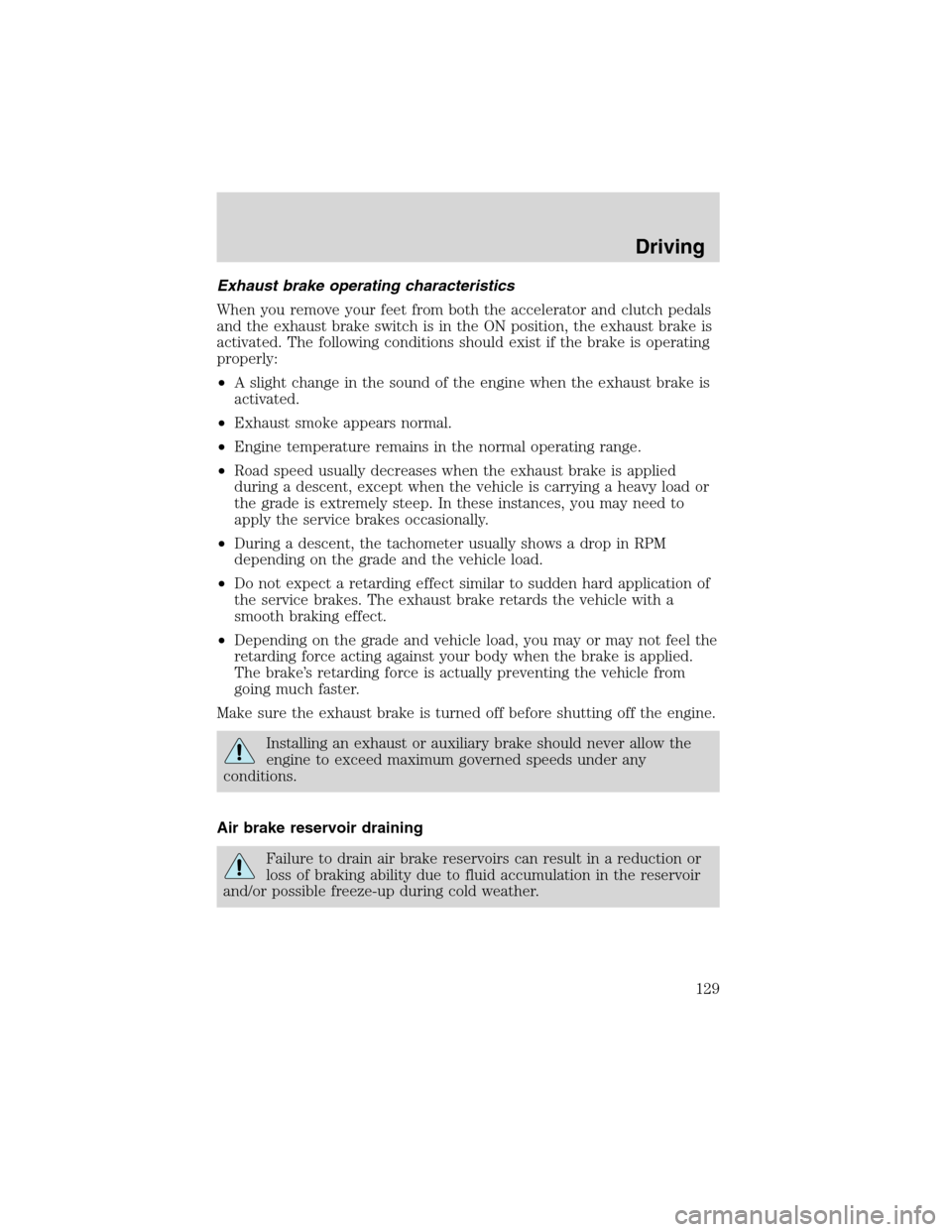
Exhaust brake operating characteristics
When you remove your feet from both the accelerator and clutch pedals
and the exhaust brake switch is in the ON position, the exhaust brake is
activated. The following conditions should exist if the brake is operating
properly:
•A slight change in the sound of the engine when the exhaust brake is
activated.
•Exhaust smoke appears normal.
•Engine temperature remains in the normal operating range.
•Road speed usually decreases when the exhaust brake is applied
during a descent, except when the vehicle is carrying a heavy load or
the grade is extremely steep. In these instances, you may need to
apply the service brakes occasionally.
•During a descent, the tachometer usually shows a drop in RPM
depending on the grade and the vehicle load.
•Do not expect a retarding effect similar to sudden hard application of
the service brakes. The exhaust brake retards the vehicle with a
smooth braking effect.
•Depending on the grade and vehicle load, you may or may not feel the
retarding force acting against your body when the brake is applied.
The brake’s retarding force is actually preventing the vehicle from
going much faster.
Make sure the exhaust brake is turned off before shutting off the engine.
Installing an exhaust or auxiliary brake should never allow the
engine to exceed maximum governed speeds under any
conditions.
Air brake reservoir draining
Failure to drain air brake reservoirs can result in a reduction or
loss of braking ability due to fluid accumulation in the reservoir
and/or possible freeze-up during cold weather.
Driving
129
Page 130 of 248
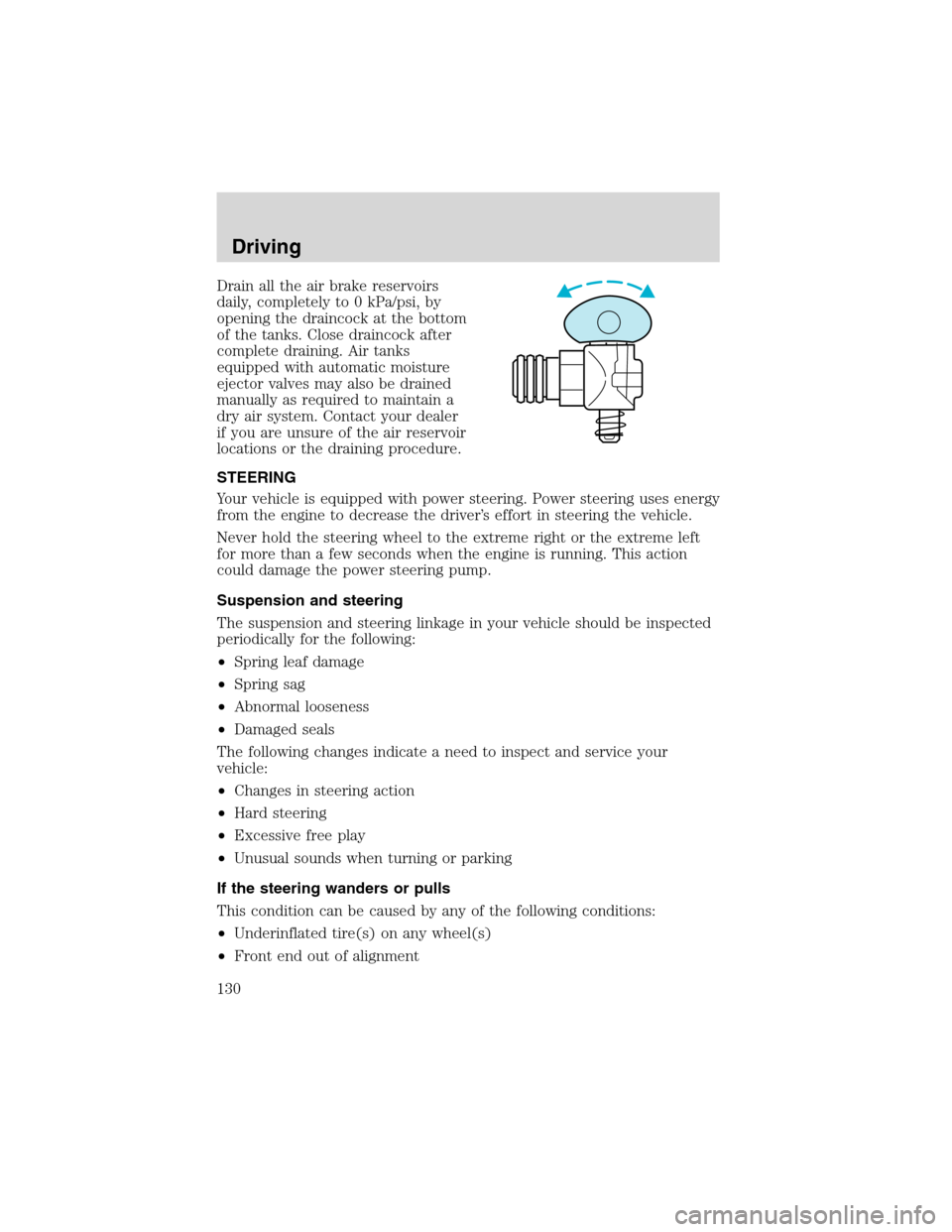
Drain all the air brake reservoirs
daily, completely to 0 kPa/psi, by
opening the draincock at the bottom
of the tanks. Close draincock after
complete draining. Air tanks
equipped with automatic moisture
ejector valves may also be drained
manually as required to maintain a
dry air system. Contact your dealer
if you are unsure of the air reservoir
locations or the draining procedure.
STEERING
Your vehicle is equipped with power steering. Power steering uses energy
from the engine to decrease the driver’s effort in steering the vehicle.
Never hold the steering wheel to the extreme right or the extreme left
for more than a few seconds when the engine is running. This action
could damage the power steering pump.
Suspension and steering
The suspension and steering linkage in your vehicle should be inspected
periodically for the following:
•Spring leaf damage
•Spring sag
•Abnormal looseness
•Damaged seals
The following changes indicate a need to inspect and service your
vehicle:
•Changes in steering action
•Hard steering
•Excessive free play
•Unusual sounds when turning or parking
If the steering wanders or pulls
This condition can be caused by any of the following conditions:
•Underinflated tire(s) on any wheel(s)
•Front end out of alignment
Driving
130